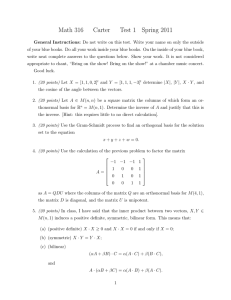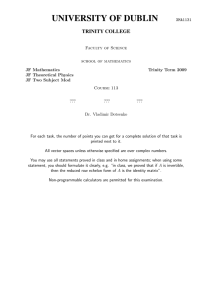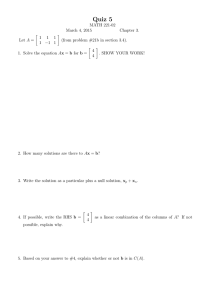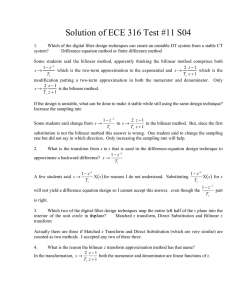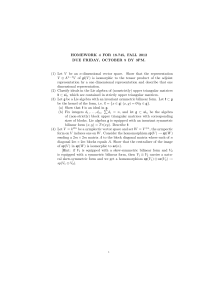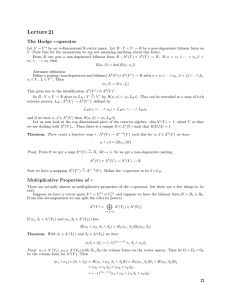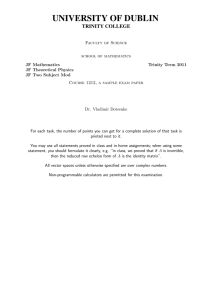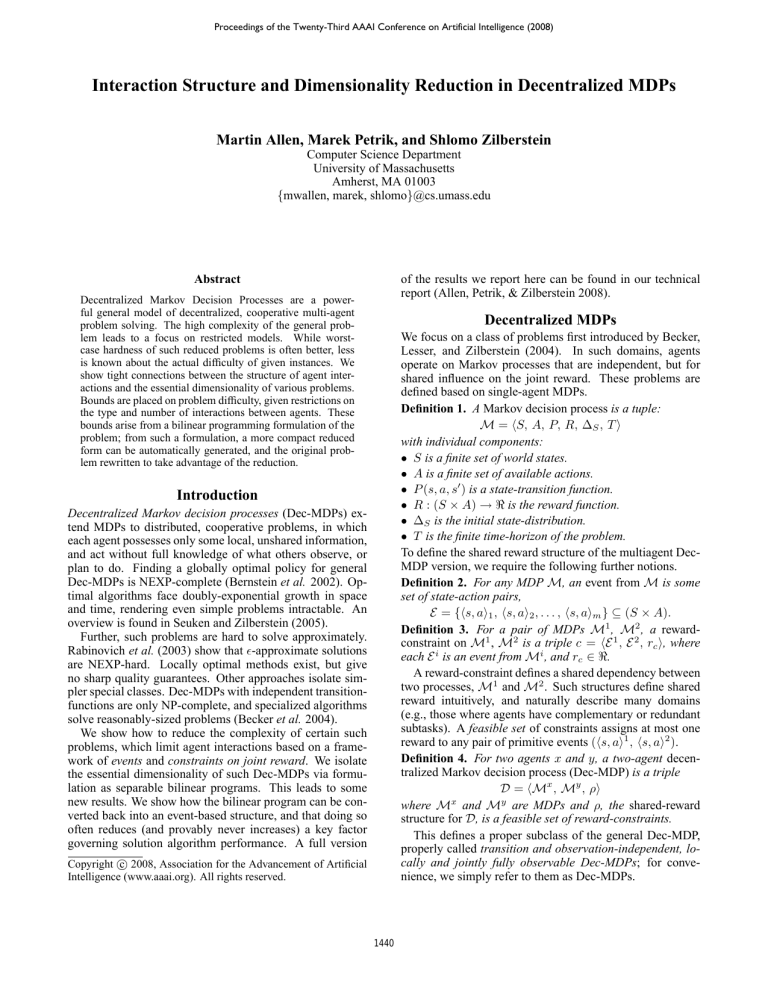
Proceedings of the Twenty-Third AAAI Conference on Artificial Intelligence (2008)
Interaction Structure and Dimensionality Reduction in Decentralized MDPs
Martin Allen, Marek Petrik, and Shlomo Zilberstein
Computer Science Department
University of Massachusetts
Amherst, MA 01003
{mwallen, marek, shlomo}@cs.umass.edu
Abstract
of the results we report here can be found in our technical
report (Allen, Petrik, & Zilberstein 2008).
Decentralized Markov Decision Processes are a powerful general model of decentralized, cooperative multi-agent
problem solving. The high complexity of the general problem leads to a focus on restricted models. While worstcase hardness of such reduced problems is often better, less
is known about the actual difficulty of given instances. We
show tight connections between the structure of agent interactions and the essential dimensionality of various problems.
Bounds are placed on problem difficulty, given restrictions on
the type and number of interactions between agents. These
bounds arise from a bilinear programming formulation of the
problem; from such a formulation, a more compact reduced
form can be automatically generated, and the original problem rewritten to take advantage of the reduction.
Decentralized MDPs
We focus on a class of problems first introduced by Becker,
Lesser, and Zilberstein (2004). In such domains, agents
operate on Markov processes that are independent, but for
shared influence on the joint reward. These problems are
defined based on single-agent MDPs.
Definition 1. A Markov decision process is a tuple:
M = hS, A, P, R, ∆S , T i
with individual components:
• S is a finite set of world states.
• A is a finite set of available actions.
• P (s, a, s′ ) is a state-transition function.
• R : (S × A) → ℜ is the reward function.
• ∆S is the initial state-distribution.
• T is the finite time-horizon of the problem.
To define the shared reward structure of the multiagent DecMDP version, we require the following further notions.
Definition 2. For any MDP M, an event from M is some
set of state-action pairs,
E = {hs, ai1 , hs, ai2 , . . . , hs, aim } ⊆ (S × A).
Definition 3. For a pair of MDPs M1 , M2 , a rewardconstraint on M1 , M2 is a triple c = hE 1 , E 2 , rc i, where
each E i is an event from Mi , and rc ∈ ℜ.
A reward-constraint defines a shared dependency between
two processes, M1 and M2 . Such structures define shared
reward intuitively, and naturally describe many domains
(e.g., those where agents have complementary or redundant
subtasks). A feasible set of constraints assigns at most one
reward to any pair of primitive events (hs, ai1 , hs, ai2 ).
Definition 4. For two agents x and y, a two-agent decentralized Markov decision process (Dec-MDP) is a triple
D = hMx , My , ρi
where Mx and My are MDPs and ρ, the shared-reward
structure for D, is a feasible set of reward-constraints.
This defines a proper subclass of the general Dec-MDP,
properly called transition and observation-independent, locally and jointly fully observable Dec-MDPs; for convenience, we simply refer to them as Dec-MDPs.
Introduction
Decentralized Markov decision processes (Dec-MDPs) extend MDPs to distributed, cooperative problems, in which
each agent possesses only some local, unshared information,
and act without full knowledge of what others observe, or
plan to do. Finding a globally optimal policy for general
Dec-MDPs is NEXP-complete (Bernstein et al. 2002). Optimal algorithms face doubly-exponential growth in space
and time, rendering even simple problems intractable. An
overview is found in Seuken and Zilberstein (2005).
Further, such problems are hard to solve approximately.
Rabinovich et al. (2003) show that ǫ-approximate solutions
are NEXP-hard. Locally optimal methods exist, but give
no sharp quality guarantees. Other approaches isolate simpler special classes. Dec-MDPs with independent transitionfunctions are only NP-complete, and specialized algorithms
solve reasonably-sized problems (Becker et al. 2004).
We show how to reduce the complexity of certain such
problems, which limit agent interactions based on a framework of events and constraints on joint reward. We isolate
the essential dimensionality of such Dec-MDPs via formulation as separable bilinear programs. This leads to some
new results. We show how the bilinear program can be converted back into an event-based structure, and that doing so
often reduces (and provably never increases) a key factor
governing solution algorithm performance. A full version
Copyright c 2008, Association for the Advancement of Artificial
Intelligence (www.aaai.org). All rights reserved.
1440
Bilinear Programs and Dec-MDPs
Applications and Conclusions
Petrik and Zilberstein (2007) have demonstrated how this
class of Dec-MDPs can be represented and solved as separable bilinear programs. We have simplified that presentation somewhat here. For Dec-MDP D = hMx , My , ρi, we
define the equivalent bilinear program:
maximize r1T x + xT Ry + r2T y
(1)
subject to Ax x = ∆S x
x≥0
Ay y = ∆S y
y≥0
The variable-vectors x and y correspond to the possible
state-action pairs from the two MDPs. Each linear rewardvector ri in the objective function is the individual agent
reward, taken from Ri ∈ Mi . The matrices Ai encode
state-visitation information, so that the multiplication in the
constraints generates the original state distribution ∆S i , preserving total flow in the system for each state. Note that all
elements so far are linear. However, we get generally nonlinear behavior in the objective function via the matrix R,
encoding the shared-reward structure of the Dec-MDP.
The dimensionality of a bilinear program for a Dec-MDP
is simply n, the size of the y-dimension of shared-reward
matrix R. Dimensionality has been observed to dominate
the complexity of solving such programs, and we prove that
it is tightly bound to the shared reward constraint structure. A given Dec-MDP can easily and automatically be
reduced to its essential dimensions, using elementary matrix
operations to eliminate all constant dimensions of y (along
which the best response for agent y is the same for anything
x does). Furthermore, we can then go back to the original problem formulation, and replace the reward-constraint
structure with a new one, often smaller. This means that
we can preserve the often more intuitive structure, based on
events, and use algorithms exploiting this sort of structure.
These techniques are of more than formal interest. Our
ongoing research has applied the presented techniques to
a number of standard benchmark domains. For instance,
in a multi-access broadcast problem, dimensionality (and
the number of necessary events) is reduced to 3 no matter
what the original problem size, providing a potentially very
large reduction for the event-based specification. When applied to instances of the standard version of the decentralized tiger problem, the number of necessary events is reduced by about a factor of 5, from 108 to 20, with a reward
loss of at most 2%. Since even linear reductions in the number of events provides exponential potential speed-ups for
specialized Dec-MDP methods like the Coverage Set Algorithm (Becker et al. 2004), this transforms such problem
instances from ones that are simply infeasible to those that
can be practically solved after all.
In analytical terms, this method allows us to reveal the essential structure of dependencies between agents in a DecMDP. By converting to the reduced form, find a more minimal set of events suitable for representing a domain. The
event-based formulation is very convenient and intuitive, but
can be highly inefficient. While simple techniques for merging events exist, they are limited. In fact, problems can be
such that there is simply no way of reducing the size of the
event formulation, so long as we use state- action pairs. Our
reduction process handles this automatically, and has potential applications for multiagent planning systems, where it
can be used to prune out unnecessary events, and simplify
the structure of designed systems and control hierarchies.
Acknowledgments
Constraints and Dimensionality
This work was supported in part by the Air Force Office of
Scientific Research under Grant No. FA9550-05-1-0254 and
by the National Science Foundation under Grants No. IIS0328601.
We show that reductions in bilinear dimensionality correspond to a reduced event-based formulation. We establish a
theorem, and some related results:
Theorem 1: The essential dimensionality of the bilinear
formulation can be bounded above in advance, based on
the reward-structure of the original Dec-MDP.
Fact 1: Given a dimensionality-reduced bilinear formulation, we can convert it directly back into an event-based
structure with a fixed number of constraints.
Fact 2: The number of such constraints can be bounded
above based on the structure of the bilinear program.
These then allow us to establish our main result, namely that
by putting a Dec-MDP, D, in reduced bilinear form, and then
rewriting it in terms of the induced reward structure, we can
only reduce the number of constraints required.
Theorem 2. Let D be a Dec-MDP with reward structure
of size |ρ| = n; let D− be the compactified bilinear form
of the problem, and ρ− be the corresponding event-based
constraint structure. Then we have that:
ρ− ≤ |ρ| ,
and the number of necessary constraints never increases.
Allen, M.; Petrik, M.; and Zilberstein, S. 2008. Interaction
structure and dimensionality in decentralized problem solving.
Technical Report UM-CS-2008-11, University of Massachusetts
Amherst, Department of Computer Science.
Becker, R.; Zilberstein, S.; Lesser, V.; and Goldman, C. V. 2004.
Solving transition independent decentralized MDPs. Journal of
Artificial Intelligence Research 22:423–455.
Bernstein, D. S.; Givan, R.; Immerman, N.; and Zilberstein, S.
2002. The complexity of decentralized control of Markov decision processes. Math. Operations Research 27(4):819–840.
Petrik, M., and Zilberstein, S. 2007. Anytime coordination using separable bilinear programs. In Proceedings of the TwentySecond Conference on Artificial Intelligence, 750–755.
Rabinovich, Z.; Goldman, C. V.; and Rosenschein, J. S. 2003.
The complexity of multiagent systems: The price of silence. In
Proceedings of the Second International Joint Conference on Autonomous Agents and Multi-Agent Systems, 1102–1103.
Seuken, S., and Zilberstein, S. 2005. Formal models and algorithms for decentralized control of multiple agents. Technical
Report UM-CS-2005-68, University of Massachusetts, Amherst,
Department of Computer Science.
References
1441


